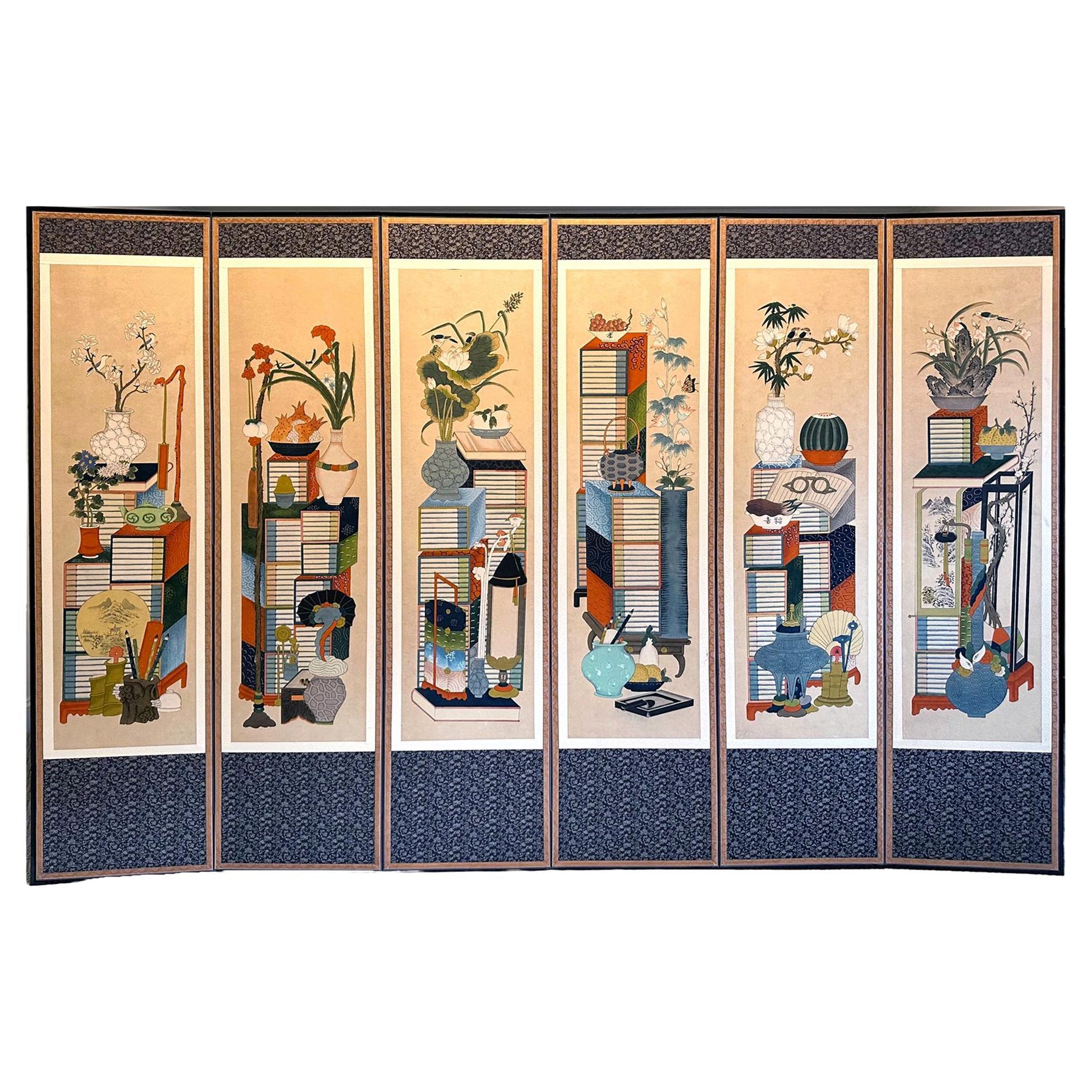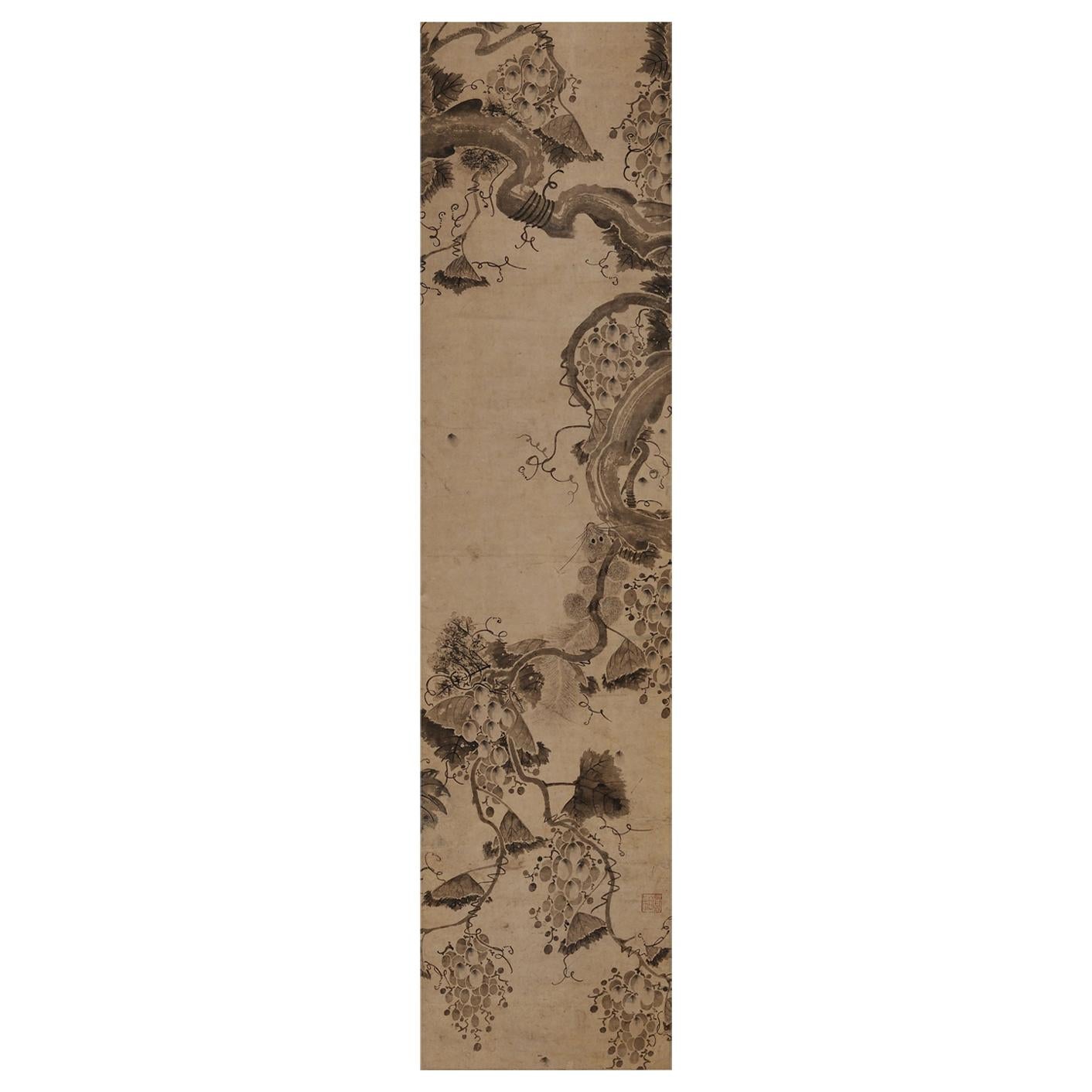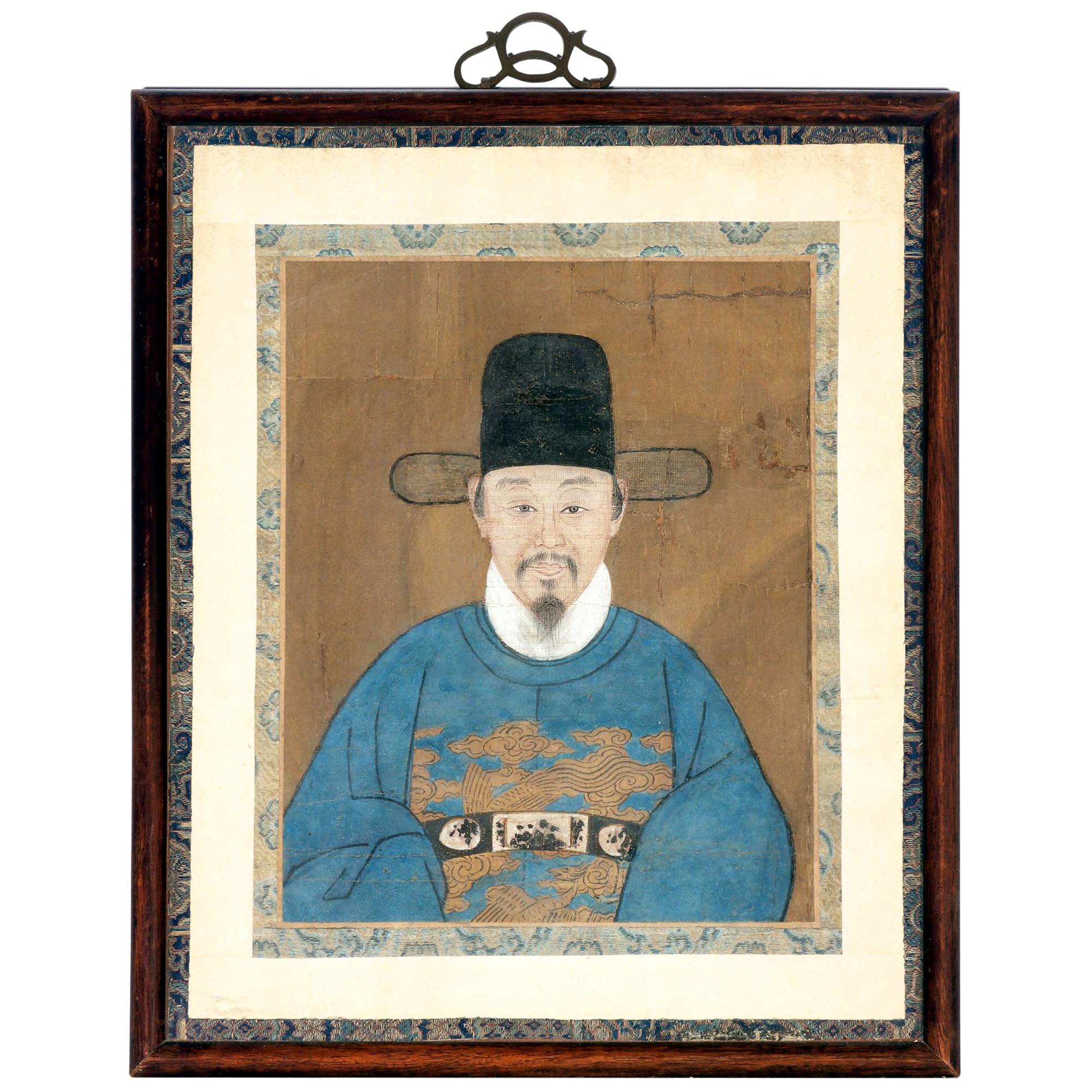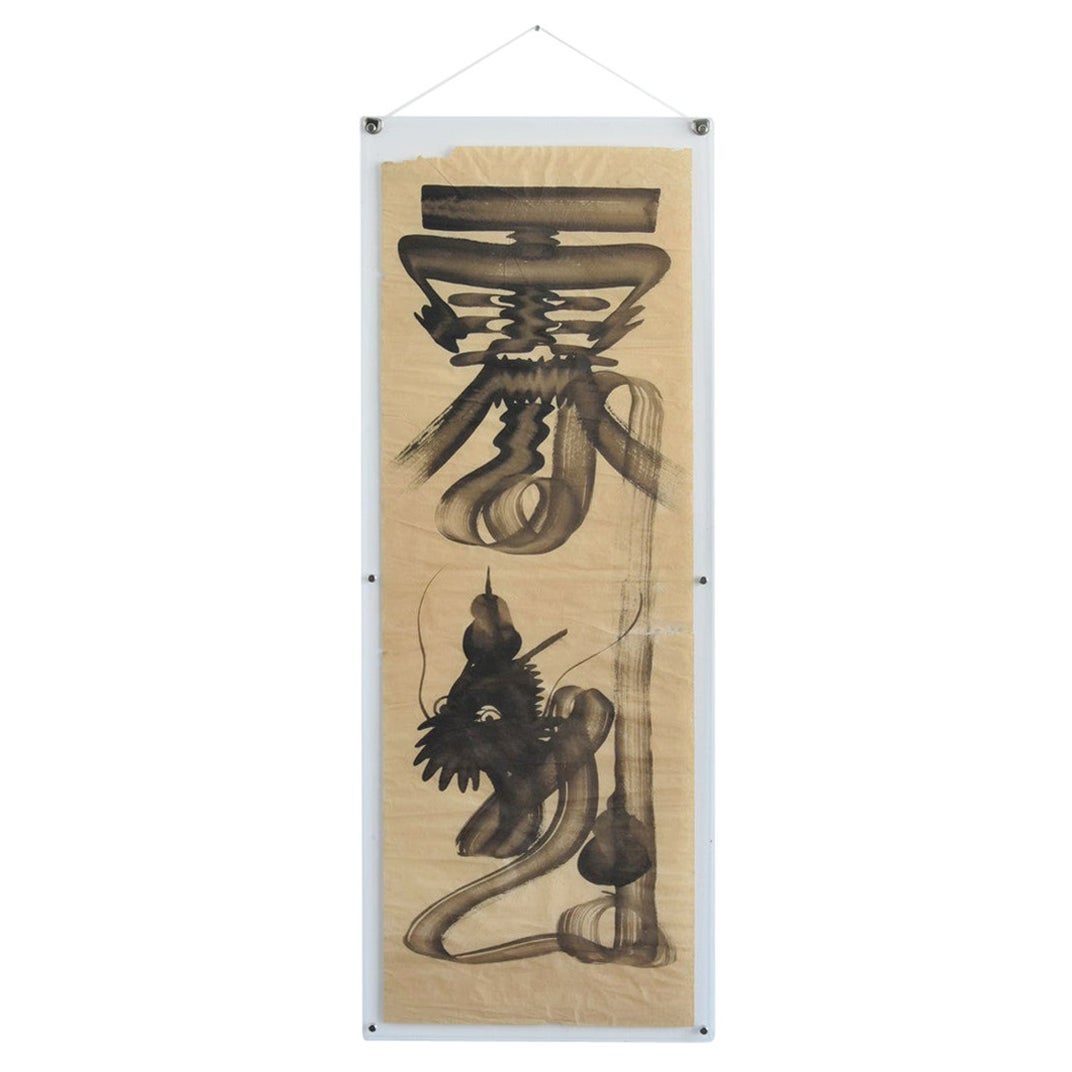Items Similar to Korean Chaekgeori painting. 19th Century Joseon. Books & Scholars’ Accouterments
Want more images or videos?
Request additional images or videos from the seller
1 of 6
Korean Chaekgeori painting. 19th Century Joseon. Books & Scholars’ Accouterments
About the Item
Books and Scholars’ Accouterments; Chaekgeori
Second half of the 19th century
Korean framed panel. Ink and color on paper.
This Korean Chaekgeori painting depicts two open shelves in a rough approximation of Western linear perspective, creating an appearance of three-dimensional depth. The lower shelf displays Chinese porcelain, an archaic Chinese bronze and a clock set against a luminous rear panel of deep blue. The upper shelf is stacked with books.
Of the various kinds of Korean decorative painting which were popular towards the end of the Joseon period (1392-1897), Chaekgeori or chaekgado is the genre that most embodies the spirit and aspirations of the period’s literati. The genre depicts books and other material commodities as symbolic embodiments of knowledge, power and aspiration. Chinese curiosities from the Qing dynasty (1644–1912) entered the homes of the upper classes of Korea during this period, and this is reflected in these paintings. Books mingle with scholarly objects, all competing for prominence of place and the attention of the viewer. The clock is an example of new technology brought to East Asia via Jesuit missionaries and Western merchants.
This panel is the work of a Korean court painter who created paintings for the elite of Korean society. There was a complex family lineage of professional painters and they transmitted painting themes and styles within those families. The elements of this panel, including the Chinese bronze and porcelain and the clock are reproduced virtually identically in a number of important Chaekgeori screen paintings dating to the second half of the 19th century. It is directly comparable to a work by Yi Taek-gyun in the Cleveland Museum of Art. Its size is highly unusual. It is a single sheet measuring 20” across and 36” high (51cm x 92cm). The question remains as to whether this was originally designed as a single panel or whether it was originally part of a folding screen. Thus far Korean Chaekgeori have only been discovered in folding screen formats of 8, 10 and 12 panels. The width of these screen panels ranges from 8.25” to 13.75” (21cm to 35cm). The 20” width of this panel lends substantial weight to the theory that it was painted to be displayed as a single panel as it is currently presented.
- Dimensions:Height: 47.5 in (120.65 cm)Width: 26.5 in (67.31 cm)Depth: 0.75 in (1.91 cm)
- Style:Edo (Of the Period)
- Materials and Techniques:
- Place of Origin:
- Period:
- Date of Manufacture:Circa 1880
- Condition:Replacements made: Recently completely remounted and reframed. One replacement section of painting/paper at the lower right corner. The was restored during a previous restoration. Refinished. Minor losses.
- Seller Location:Kyoto, JP
- Reference Number:1stDibs: LU2472339273642
About the Seller
5.0
Recognized Seller
These prestigious sellers are industry leaders and represent the highest echelon for item quality and design.
Gold Seller
These expertly vetted sellers are highly rated and consistently exceed customer expectations.
Established in 2001
1stDibs seller since 2016
60 sales on 1stDibs
Typical response time: 6 hours
- ShippingRetrieving quote...Ships From: Kyoto, Japan
- Return PolicyA return for this item may be initiated within 10 days of delivery.
More From This SellerView All
- 17th Century Korean Grapevine and Squirrel Scroll Painting, Mid Joseon PeriodLocated in Kyoto, JPAnonymous. Korean, 17th century. Joseon period. Hanging scroll. Ink on paper. Seal: Shinso Dimensions: Scroll: H. 200 cm x W. 31 cm (79” x 12”) Image: H. 122 cm x W. 29.5 cm (48” x 11.5”) The grapevine came to China and then Korea from western Asia via the silk road trade routes. By the mid-Joseon period, it was one of the most popular subjects for Korean literati painters. Grapevines were painted as a singular subject or, less commonly, in combination with squirrels, which are associated with children due to their playful nature. Together, grapevines and squirrels embody wishes for abundant offspring and wealth. For the Korean literati artist the twisting vines, curling tendrils and round, plump grapes provided ample opportunity for expressive "brush play”. In this painting the artist has abstracted the scene and is seemingly unconcerned with discontinuities and proportion. Vines spring up from nowhere, grapes hang in random clusters and the squirrel’s head appears as if twisted backwards. For the vines and leaves we can feel a sense of speed in the brushstrokes, imparting a dynamic feel which is at once intense and animated. This contrasts dramatically with the countless tiny strokes of ink which realistically capture the texture of the squirrel’s fur...Category
Antique 17th Century Korean Other Paintings and Screens
MaterialsPaper
- Japanese Painting, Hanging Scroll, 19th Century Bamboo in MoonlightLocated in Kyoto, JPBamboo in moonlight Gamo Rakan (1784-1866) Hanging scroll, ink on silk. Dimensions: Scroll: 201 cm x 58 cm Image: 137 cm x 45 cm In this early 19th century work by Gamo Rakan a light ink wash applied to the silk background silhouettes the moon and suggests the atmosphere of early evening. Even though it is a literati subject, Rakan’s bamboo is quite realistic with a strong decorative style. The painting finds its inspiration from Chinese Ming dynasty painters who often used a single-tone, jet black stroke to emphasize the calligraphic nature of bamboo. In a different era, decorative would have been seen as somewhat unrefined. But increasingly in the Edo period, it was the hallmark of high style. The Japanese people, in particular the rising merchant class, had gradually become apathetic toward the traditional Sesshu and Kano schools of painting. Chinese professional and amateur painters living in the port of Nagasaki during the 18th century had a profound effect on Japanese painting and the freshness of their style and its decorative appeal contributed greatly to its popularity. Gamo Rakan’s teacher, Tani Buncho...Category
Antique Early 19th Century Japanese Edo Paintings and Screens
MaterialsSilk
- 19th Century Japanese Scroll Painting by Igarashi Chikusa, Poppies & ButterfliesLocated in Kyoto, JPPoppies & Butterflies Ink, pigment and gofun on silk Igarashi Chikusa (1774-1844) Signature: Chikusa Ran Zen Upper Seal: Ran Shuzen Lower Seal: Kyoho Dimensions: Scroll: H. 68” x W. 18” (172cm x 45cm) Image: H. 38.5’’ x W. 12.5’’ (98cm x 32cm) This composition shows elegant images of poppies and the butterflies that are inevitably drawn to them. It captures a momentary glimpse into a world both visually dazzling and startlingly realistic. The painting is infused with sensitivity and attention to seasonal change and weather conditions. The thin and fragile poppies are beautifully depicted with brilliant colors and the butterflies are similarly infused with life. The painting is on silk which requires extremely precise painting skills as no element once painted can be removed. Poppies were a favorite subject of Rinpa school artists through the ages. Originally they were somewhat abstracted but by the age of Sakai Hoitsu...Category
Antique Early 19th Century Japanese Edo Paintings and Screens
MaterialsSilk
- 19th Century Japanese Silk Painting by Kano Chikanobu, Phoenix & PaulowniaLocated in Kyoto, JPBirds & Flowers of the seasons Pheasants & Plum in Snow Unframed painting. Ink, pigment and gofun on silk Kano Chikanobu 1819-1888 Signature...Category
Antique Mid-19th Century Asian Edo Paintings and Screens
MaterialsSilk
- 19th Century Japanese Silk Painting by Kano Chikanobu, Turtles & AzaleaLocated in Kyoto, JPBirds & flowers of the seasons Pheasants & plum in snow Unframed painting. Ink, pigment and gofun on silk Kano Chikanobu 1819-1888 Signature...Category
Antique Mid-19th Century Asian Edo Paintings and Screens
MaterialsSilk
- 19th Century Japanese Silk Painting by Kano Chikanobu, Sparrows & NandinaLocated in Kyoto, JPBirds & flowers of the seasons Pheasants & plum in snow Unframed painting. Ink, pigment and gofun on silk Kano Chikanobu 1819-1888 Signature...Category
Antique Mid-19th Century Asian Edo Paintings and Screens
MaterialsSilk
You May Also Like
- Korean Folding Chaekgeori Painted Scholar Floor ScreenLocated in Atlanta, GAA six-panel painted folding floor screen from Korea circa early 20th century. This type of screen is called Chaekgeori (books and things) which is quite unique to Korea. It became popular at the end of 18th century favored and encouraged by King Jeongjo (1752-1800) as a political tool to promote social conservatism such as the traditional Confucianism value, especially considered important in a time when waves of new ideology influx came to Korea. Initially commissioned for the royal court, they became increasingly popular with the scholars of noble and affluent household and used it widely in their halls and studies. Early screens were painted with trompe-l’oeil bookcases displaying books and arrays of collectibles. Later, the bookcases were eliminated to focus on the assemblage of neatly stacked books and objects of scholarly pursue. On this screen, the six panels were neatly presented and framed in woven brocade borders. Among the stacked volumes, one can find many fine porcelain vases with flowers, potted orchids, pen holders with brush pens and scroll paintings, incense burner, ink stone, teapot, fan with ink painting, vessels of fruits, exotic plants such as lotus, plumeria and even a pair of glasses. It feels like a pleasant visual measure hunting for the viewers. Several words in Chinese found their way into the picture as well, including filial (xiao), longevity (shou) and luck (fu). The painting was done in a meticulous way with no details overlooked and also with a rather western still-life dimensional perspective. In a rather unusual maximal but also minimalistic way, the screen exudes a folky charm but appears modern at the same time. Each panel is 17.5"w by 70.2"h. For general information on the subject see reference: Chaekgeori the Power and Pleasure of Possessions in Korean Painted Screens...Category
20th Century Korean Folk Art Paintings and Screens
MaterialsBrocade, Silk, Wood, Paper
- 19th Century Watercolor Painting of a Scholar and His StudentsLocated in Lambertville, NJ19th Century Chinese watercolor in vivid colors of a teacher seated at a desk under a tree with students seated on cushions in an outd...Category
Antique Late 19th Century Chinese Chinoiserie Paintings and Screens
MaterialsHardwood, Paper
- Framed Korean Official Portrait Joseon DynastyLocated in Atlanta, GAA hyper realistic portrait of an official with watercolor on silk bordered panel, framed in dark wood, from Korean late Joseon dynasty, circa 19th century. The beard man sitting with a formal frontal view, displays a benevolent facial expression, in keeping with the Confucius value of the officialdom at the time. He dons a black linen official hat and a blue silk robe...Category
Antique 19th Century Korean Other Paintings and Screens
MaterialsSilk, Wood
- Korean Minhwa Jakhodo Tiger and Magpie Scroll Painting on Silk, 19th CenturyLocated in Studio City, CAA wonderfully painted and detailed Korean folk art Minhwa Jakhodo (The letters “jak” means magpie; “ho” means tiger; and “do” means painting) Tiger and Magpie Scroll Painting. The pi...Category
Antique 19th Century Korean Folk Art Paintings and Screens
MaterialsSilk, Wood, Paint
- Japanese Antique Ink Painting / 19th Century / Rare Chinese Character PaintingLocated in Sammu-shi, ChibaWe have a unique Japanese aesthetic sense. And only we can introduce unique items through our purchasing channels in Japan and the experience we have gained so far, in such a way that no one else can imitate. It is an ink painting written after the Meiji era. The biggest attraction of this work is that it uses Chinese characters to create paintings. To explain in detail, it is written here in Chinese characters as "un-ryu" . "Un" is a cloud and "ryu" is a dragon. These are embodied and drawn by comparing them to the meaning of Chinese characters. And the clouds depict the clouds hanging over the mountain, and the dragon depicts the climbing toward the mountain. Humorous paintings...Category
Antique Late 19th Century Japanese Edo Paintings
MaterialsAcrylic, Paper
- 19th Century Chinese PaintingLocated in Dallas, TXImperial portrait on paper.Category
Antique 18th Century Chinese Other Paintings and Screens
MaterialsPaint
Recently Viewed
View AllMore Ways To Browse
Meiji Era Paintings
Victorian Bench Seat
Pair Of Benches Ottoman
Venice Cocktail Table
Vintage Black Metal Stool
Try Tray Clear
Turkmen Main Carpet
Rustic Spanish Dining Chairs
Vintage Roll Chart
Vintage Rollable Chart
Console Table With 3 Drawers
Spanish Baroque Carving
Wrought Iron Bronze Chandelier
Mobelfabrik Curved Wood Chairs
Pair Of 1940s Art Deco Lounge Chairs
Terra Cotta Figural
Mid Century Campaign Chest Of Drawers
Three Stack Double





